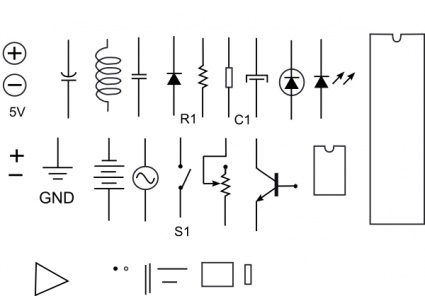
Nearly all of the official names for the electrical units of measurement are in honour of the 19th century pioneers in the electrical field. These are detailed below.
Voltage - Volt
The volt (symbol: V) is the SI derived unit for electric potential, electric potential difference, and electromotive force. The volt is named in honour of the Italian physicist Alessandro Volta (1745–1827), who invented the voltaic pile, possibly the first chemical battery.
Current - Ampere
The ampere (symbol: A) is the SI unit of electric current (symbol: I) and is one of the seven SI base units. It is named after André-Marie Ampère (1775–1836), French mathematician and physicist, considered the father of electrodynamics. In practice, its name is often shortened to amp.
Resistance - Ohm
The Ohm (symbol: R) is the SI unit of electrical resistance. Ohm's Law is one of the fundamental laws of electrical circuits. The law was named after the German physicist Georg Ohm, who, in a treatise published in 1827, described measurements of applied voltage and current through simple electrical circuits containing various lengths of wire.
Conductance - Siemen
The Siemen (symbol: S) is the SI derived unit of electric conductance and electric admittance. Conductance and admittance are the reciprocals of resistance and impedance respectively, hence one siemens is equal to the reciprocal of one ohm, and is sometimes referred to as the mho. It is named after the German inventor and industrialist Ernst Werner von Siemens.
Capacitance - Farad
A farad is the charge in coulombs which a capacitor will accept for the potential across it to change 1 volt. A coulomb is 1 ampere second. The farad (symbol: F) is the SI unit of capacitance. The unit is named after the English physicist Michael Faraday.

Charge - Coulomb
The coulomb (symbol: C) is the SI derived unit of electric charge. It is defined as the charge transported by a steady current of one ampere in one second. One coulomb is also the amount of excess charge on the positive side of a capacitance of one farad charged to a potential difference of one volt.
This SI unit is named after Charles-Augustin de Coulomb. As with every SI unit whose name is derived from the proper name of a person, the first letter of its symbol is upper case (C).
Inductance - Henry
In physics, and electronics, the henry (symbol H) is the SI unit of inductance[1]. It is named after Joseph Henry (1797–1878), the American scientist who discovered electromagnetic induction independently of and at about the same time as Michael Faraday (1791–1867) in England. The magnetic permeability of the vacuum is 4p×10-7 H/m (henry per meter)
Power - Watt
The watt (Symbol: W) is a derived unit of power in the International System of Units (SI), named after the Scottish engineer James Watt (1736–1819). The unit, defined as one joule per second, measures the rate of energy conversion.
Frequency - Hertz
For cyclical processes, such as rotation, oscillations, or waves, frequency is defined as a number of cycles per unit time. In physics and engineering disciplines, such as optics, acoustics, and radio, frequency is usually denoted by a Latin letter f or by a Greek letter ? (nu).
In SI units, the unit of frequency is the hertz (Hz), named after the German physicist Heinrich Hertz: 1 Hz means that an event repeats once per second. A previous name for this unit was cycles per second.
Energy - Joule
The joule (Symbol J) is a derived unit of energy or work in the International System of Units. It is equal to the energy expended (or work done) in applying a force of one newton through a distance of one metre (1 newton metre or N·m), or in passing an electric current of one ampere through a resistance of one ohm for one second. It is named after the English physicist James Prescott Joule (1818–1889).
The Cache
The cache is located at S29 xx.xxx and E30 xx.xxx. Parking co-ordinates are supplied with the GeoCheck solution.
